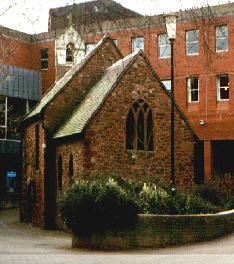
|

|
| Tiger Bill's | Gaumont Cinema and North Street |
| The City Gate Hotel | Iron Bridge and North Gate |
| HUB | Bartholomew St Cemetery |
| La Boca | St Olaves Close |
| Mosaic | St Mary Arches Church and Street |
| The Hogs Head | Lower Market |
| The Firestone | Palace Gate, Bear Street, Sacred Heart Church, Baptist Church |
| The White Hart | South Gate, Holy Trinity Church |
| George's Meeting House | Global Village |
| Tiggas | Wynards Almshouse, Southgate Hotel, Devon and Exeter Hospital |
| Cafe Paradiso and Kinos Bar | Old Eye Infirmary |
| The Hourglass Inn | Colleton Cresent |
| Use the text links for more information! |
No sidebar menus?, Click Here and re-select |
 |
All change As you exit Martins Lane, in front of you and slightly to your right you'll see Tudor and Jacobean shop frontages that were renovated when C&A moved in during 1972. Boots had occupied this site before they moved to the top of the High Street in the early seventies. Tesco moved in when C&A ceased trading in the UK in February 2001. Turn left and immediately on your left is Laura Ashley housed in a pair of gable-ended buildings dating from 1549. The pair in fact were built as a single structure. Head south west down High Street past Marks and Spencer (the former site of Waltons), you are following the old path of the Roman Ickneild Way at this point. For further information on the buildings in High Street, click here. |
| St Petrock's, Banks and Gate
To your right you'll see the Guildhall
and on the opposite side of the road is the tall red tower of St. Petrock's Church. At this
point before the main road was diverted to its present course, the Ickneild
Way took a turn to the left and ran across part of what is now the Cathedral
Close and continued its course to the river through the down and through
the West Gate. The High Street was diverted to its present position when
the Cathedral's Wall was built after 1286. Take a look at the plaque and post on the
wall of the Halifax Bank
which marks the old site of Broadgate (removed 1825), one of the old cathedral gates.
Before Broadgate was constructed, this approach to the Cathedral Yard was called The Fissand. The
gate was also known as St Michaels Gate because of the staue of St Michael the Archangel overcoming the
Devil which stood above the gate.
The Halifax occupies the site of one Exeter's first banks,
the Exeter Bank which was originally built adjoining the building that
became the Royal Clarence Hotel. If you look closely you'll see that the Halifax occupies two original buildings, those of
the Exeter Bank and the City Bank.
|
 |
| Turks Head
The Turks Head was one of Exeter's oldest pubs,
but unfortunately closed on 6th January 2005. See the Bygone section of this website for more information.
Inside you would have found a large bar area, and
being a fairly central pub this place was generally packed on Friday & Saturday
nights. The ceiling of front bar was fairly interesting and hadn't really
been touched despite several refurbishment's over the years. There was
a balcony with archways which was allegedly haunted by a lady in a long
flowing gown that appeared on one of the balconies. In the lower bar was
a corner in which Charles Dickens
used to sit, Dicken's Corner. It was here he
is said to have picked up Fat Boy in Pickwick Papers. He also found at
Exeter, Mrs Lupin of the Blue Dragon (Martin Chuzzlewit), and Pecksniff. Dickens
leased Mile End Cottage
in Alphington for his parents and was a frequent visitor.
Guildhall
The Guildhall next door is one of the oldest municipal properties in
England, first recorded in 1160 and at various times has been used as a
prison. |
Courts were also held in there so that justice could be administered
and executed under the same roof. The cells were used until 1887. James
Cossins mentions in his book Reminiscences of Exeter (1878), that
stocks were in place under the centre arch. For more detailed information on
the Guildhall, click the link.
Waterbeer Out the back is the Church of St. Pancras. It was here in Waterbeer Street that a new Police Station was built in 1887 and the cells in the Guildhall no longer used. This police station was moved to Heavitree Road in 1960. The Church Of St. Pancras built of Heavitree Stone has the plan of a Saxon Church and there was evidence of a Saxon door when the church was repaired last century. Another theory suggests that it was built before the Saxons in AD400. A Pavement of the praetorium was found at the end of Waterbeer St, obviously built during Roman occupation, so why not a church of Christian Romans dedicated to the boy saint, St Pancras. |
Your Comments and Feedback are very welcome